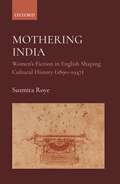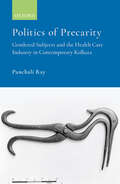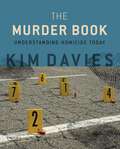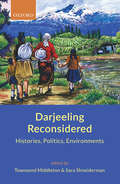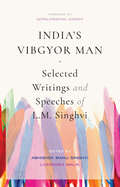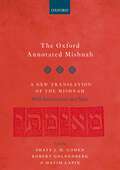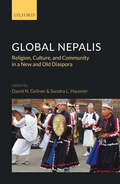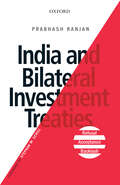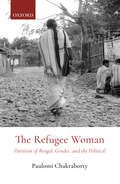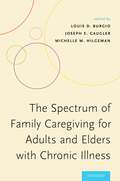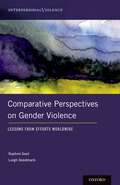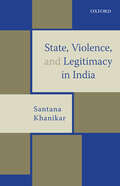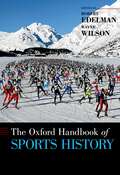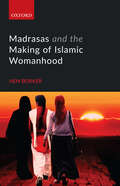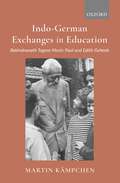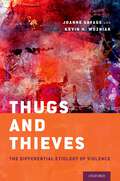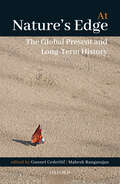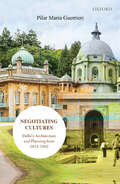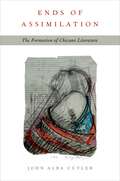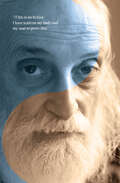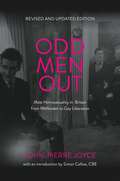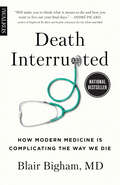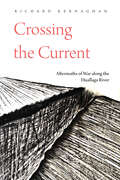- Table View
- List View
Mothering India: Women’s Fiction in English Shaping Cultural History (1890–1947)
by Susmita RoyeIndian writing in English (IWE) is now a widely recognized and awarded genre, boasting of world renowned authors in its ranks. The ‘fathers’ of IWE, Mulk Raj Anand, R.K. Narayan, and Raja Rao, have now been canonized and their works widely studied. Yet, very little scholarly attention has been paid to the pioneering literary contributions of Indian women to analyse their effect on the cultural history of their times. Mothering India addresses this lack and concentrates on early Indian women’s fiction written between 1890 and 1947. It not only evaluates the influence of women authors on the rise of IWE, but also explores how they reassessed and challenged stereotypes about womanhood in India, adding their voice to the larger debate about social reform legislations on women’s rights. Moreover, in choosing to write in the colonizer’s language, they seized the attention of a much wider international readership. In wielding their pens, these trendsetting women stepped into the literary landscape as ‘speaking subjects’, refusing the passivity of being ‘spoken-of objects’, and thereby ‘mothering’ India by redefining her image.
Politics of Precarity: Gendered Subjects and the Health Care Industry in Contemporary Kolkata
by Panchali RayPolitics of Precarity presents an analysis of contemporary labour politics that emerges with informalization and privatization of crucial social sectors, and in this case one of the few feminized occupations—the nursing sector. Contrary to common understanding, nursing service is not a homogenous sector, but a deeply splintered one based on historically and socially produced structural inequalities and is rigidly cleaved along the lines of ‘prestigious’ and ‘dirty’ work. The levels of classification in this sector are reflected in and constituted by material realities, such as wages, terms of employment, extent of skills, and possession of qualifications. Drawing on three years of fieldwork in hospitals and nursing homes in the city of Kolkata, the book is an ethnographic study that analyses how hierarchies at workplace intersect with social identities to produce a differentiated workforce. The book interrogates the politics of distinction and distancing that produces a feminine workforce divided by class, caste, and sexualities to examine the various contestations among ranks of workers who deploy modernity, morality, and gendered norms as strategies to secure marginal gains at the expense of others.
The Murder Book: Understanding Homicide Today
by Kim DaviesThe Murder Book: Understanding Homicide Today provides comprehensive coverage about the theories explaining homicide. Discussions of high-profile cases, as well as details of the day to day work of investigators and the courts, provide a complete treatment of homicide.
Darjeeling Reconsidered: Histories, Politics, Environments
by Townsend Middleton Sara ShneidermanDarjeeling occupies a special place in the South Asian imaginary with its Himalayan vistas, lush tea gardens, and brisk mountain air. Thousands of tourists, domestic and international, annually flock to the hills to taste their world-renowned tea and soak up the colonial nostalgia. Darjeeling Reconsidered rethinks Darjeeling’s status in the postcolonial imagination. Mobilizing diverse disciplinary approaches from the social sciences and humanities, this definitive collection of essays sheds fresh light on the region’s past and offers critical insight into the issues facing its people today. While the historical analyses provide alternative readings of the systems of governance, labour, and migration that shaped Darjeeling, the ethnographic chapters present accounts of dynamics that define life in twenty-first century Darjeeling, including the Gorkhaland Movement, Fair Trade tea, indigenous and subnationalist struggle, gendered inequality, ecological transformation, and resource scarcity. The volume figures Darjeeling as a vital site for South Asian and postcolonial studies and calls for a timely reexamination of the legend and hard realities of this oft-romanticized region.
India’s Vibgyor Man: Selected Writings and Speeches of L.M. Singhvi
by Abhishek Manu Singhvi Lokendra MalikDr L.M. Singhvi (1931–2007) was an eminent Indian jurist, a distinguished parliamentarian, a celebrated statesman, an able administrator, a brilliant scholar, a prolific writer, and a diplomat par excellence. He was India’s second longest-serving high commissioner to the United Kingdom, from 1991 to 1997, and was conferred the Padma Bhushan in 1998. Dr Singhvi was deeply wedded to human service, and wrote on a variety of issues which are relevant in contemporary sociopolitical discourse. This work, alluding to the multifaceted personality of Dr L.M. Singhvi, highlights his scholarly contribution in varied fields of human activities such as law, diplomacy, democracy, and literature. It brings together his unpublished papers and lectures which address topics ranging from human rights, foreign policy issues, Kashmir, centre–state relations, public administration, legal issues, to education, healthcare, civil services, and Indology. The comprehensive introduction knits together the themes discussed in the volume, and emphasizes their relevance in today’s times.
The Oxford Annotated Mishnah
The Mishnah is the foundational document of rabbinic law and, one could say, of rabbinic Judaism itself. It is overwhelmingly technical and focused on matters of practice, custom, and law. The Oxford Annotated Mishnah is the first annotated translation of this work, making the text accessible to all. With explanations of all technical terms and expressions, The Oxford Annotated Mishnah brings together an expert group of translators and annotators to assemble a version of the Mishnah that requires no specialist knowledge.
Global Nepalis: Religion, Culture, and Community in a New and Old Diaspora
by David N. Gellner Sondra L. HausnerMigration has been a basic fact of Nepali life for centuries. Over the last thirty years, migration from Nepal has increased diaspora communities across the world. In these diverse contexts, to what extent do Nepalis reproduce their culture and pass it on to subsequent generations? How much of diaspora life is a response to social and political concerns derived from the homeland? What aspects of Nepali life and culture change? In this volume twenty-one authors address these issues through eighteen detailed case studies that tackle issues of livelihood, identity and belonging, internal conflict, and religious practice, in the UK, the USA, India, Southeast Asia, the Gulf countries, and Fiji. Throughout the volume, we see how being Nepali outside Nepal enables new categories and new kinds of identity to emerge, whether as Nepali, Gorkhali, or as a member of a particular ethnic, regional, or religious group. The common theme of Global Nepalis is the exploration of continuity, change, and conflict as new practices and identities develop in Nepali diaspora life.exponentially, leading to many new
India and Bilateral Investment Treaties: Refusal, Acceptance, Backlash
by Prabhash RanjanAs a consequence of being sued by more than 20 foreign investors, India terminated close to 60 investment treaties and adopted a new Model Bilateral Investment Treaty (BIT) purportedly to balance investment protection with the host State’s right to regulate. This book is a critical study of India’s approach towards BITs and traces their origin, evolution, and the current state of play. It does so by locating them in India’s economic policy in general and policy towards foreign investment in particular. India’s approach towards BITs and policy towards foreign investment were consistent with each other in the periods of economic nationalism (1947–1990) and economic liberalism (1991–2010). However, post 2010, India’s approach to BITs has become protectionist while India’s foreign investment policy continues to be liberal. To balance investment protection with the State’s right to regulate, India needs to evolve its BIT practice based on the twin framework of international rule of law and embedded liberalism.
The Refugee Woman: Partition of Bengal, Gender, and the Political
by Paulomi ChakrabortyThe Refugee Woman examines the Partition of 1947 by engaging with the cultural imagination of the ‘refugee woman’ in West Bengal, particularly in three significant texts of the Partition of Bengal—Ritwik Ghatak’s film Meghe Dhaka Tara; and two novels, Jyotirmoyee Devi’s Epar Ganga, Opar Ganga and Sabitri Roy’s Swaralipi. It shows that the figure of the refugee woman, animated by the history of the political left and refugee movements, and shaped by powerful cultural narratives, can contest and reconstitute the very political imagination of ‘woman’ that emerged through the long history of dominant cultural nationalisms. The reading it offers elucidates some of the complexities of nationalist, communal, and communist gender-politics of a key period in post-independence Bengal.
The Spectrum of Family Caregiving for Adults and Elders with Chronic Illness
The vast majority of care provided to adults and elders with chronic illness is given in the home, most often by family members. The caregiver's role is daunting; caregiving is often referred to as a 'career,' requiring long hours and arduous tasks. Primary caregivers show higher rates of morbidity and mortality, and caregiving is a major source of stress and burden to caregiving families. Presently, very little support is available to caregivers from either State or Federal agencies. However, awareness of this worsening problem is growing among health professionals and policy makers. The Spectrum of Family Caregiving for Adults and Elders with Chronic Illness is written for individuals in the helping professions who are in roles that interface with or serve family caregivers who are supporting an adult or elder with a chronic condition. The volume includes eight disease-specific chapters written by experts from various disciplines. Each discusses the caregiving role and includes a thorough review of the literature on the characteristics of caregivers and care-recipients, including related care needs, issues, and challenges unique to that chronic illness. Chapters also review the extant literature on caregiver interventions. An Evidence Table is included in each of these chapters so that the reader can easily judge the quality of evidence supporting the intervention studies. Finally, each chapter includes two case studies describing common problems encountered by caregivers, along with descriptions of interventions used to address these problems. The final chapter summarizes the state of the science on caregiving roles and caregiver interventions and discusses the most relevant challenges and barriers faced by today's caregivers and caregiver advocates. This book will be valuable to clinicians and those in the helping professions, as well as academics and researchers with an interest in the study of family caregiving and caregiver interventions, and to health administrators, public officials, and policy makers concerned with chronic illness care and management.
Comparative Perspectives on Gender Violence: Lessons From Efforts Worldwide (Interpersonal Violence)
The United States has uncritically exported its law and policy on gender violence without regard to effectiveness or cultural context, and without asking what we might learn from efforts to combat gender violence in the rest of the world. This book asks that question. Comparative Perspectives on Gender Violence: Lessons From Efforts Worldwide documents the global scope of gender violence, from countries where the legal response is just emerging to countries with longstanding law and policy regimes. Informed by international human rights law, Comparative Perspectives on Gender Violence examines policy successes and failures and grassroots efforts to elicit a robust and proactive response from China to Chile. From the work of local activists to stem the tide of sexual and intimate partner violence after the Haitian earthquake of 2005, to the efforts to eradicate dowry-related violence in India, to the public education campaigns to prevent domestic violence in Scotland, Comparative Perspectives on Gender Violence offers a comprehensive vision of efforts around the world to eradicate gender based violence. Featuring the work of leading gender violence academics and activists around the world, Comparative Perspectives on Gender Violence provides a new lens through which to consider U.S. efforts to address gender violence.
Asking Questions About Cultural Anthropology: A Concise Introduction
by Robert L. Welsch Luis A. VivancoUnlike textbooks that emphasize the memorization of facts, Asking Questions About Cultural Anthropology: A Concise Introduction, Third Edition, teaches students how to think anthropologically, helping them view cultural issues as an anthropologist might. This approach demonstrates how anthropological thinking can be used as a tool for deciphering everyday experiences. The book covers the essential concepts, terms, and history of cultural anthropology, introducing students to the widely accepted fundamentals and providing a foundation that can be enriched by the use of ethnographies, a reader, articles, lectures, field-based activities, and other kinds of supplements. It balances concise coverage of essential content with a commitment to an active, learner-centered pedagogy.
State, Violence, and Legitimacy in India
by Santana KhanikarHow do people respond to a state that is violent towards its own citizens? In State, Violence, and Legitimacy in India, this question is addressed through insights offered by ethnographic explorations of everyday policing in Delhi and the anti-insurgency measures of the Indian army in Lakhipathar village in Assam. Battling the dominant understanding of the inverse connect between state legitimacy and use of violence, Santana Khanikar argues that use of violence does not necessarily detract from the legitimacy of the modern territorial nation-state. Based on extensive research of two sites, the book develops a narrative of how two facets of state violence, one commonly understood to be for routine maintenance of law and order and the other to be of extraordinary need for maintaining unity and integrity of the nation-state, often produce comparable responses. The book delves into the debates surrounding state–citizen relationship in India, while critically engaging with dominant notions of state legitimacy and its relation with use of violence by the state.
The Oxford Handbook of Sports History (Oxford Handbooks)
by Robert Edelman Wayne WilsonOrwell was wrong. Sports are not "war without the shooting", nor are they "war by other means." To be sure sports have generated animosity throughout human history, but they also require rules to which the participants agree to abide before the contest. Among other things, those rules are supposed to limit violence, even death. More than anything else, sports have been a significant part of a historical "civilizing process." They are the opposite of war. As the historical profession has taken its cultural turn over the last few decades, scholars have turned their attention to subject once seen as marginal. As researchers have come to understand the centrality of the human body in human history, they have come to study this most corporeal of human activities. Taking early cues from physical educators and kinesiologists, historians have been exploring sports in all their forms in order to help us answer the most fundamental questions to which scholars have devoted their lives. We have now seen a veritable explosion excellent work on this subject, just as sports have assumed an even greater share of a globalizing world's cultural, political and economic space. Practiced by millions and watched by billions, sports provide an enormous share of content on the Internet. This volume combines the efforts of sports historians with essays by historians whose careers have been devoted to more traditional topics. We want to show how sports have evolved from ancient societies to the world we inhabit today. Our goal is to introduce those from outside this sub-field to this burgeoning body of scholarship. At the same time, we hope here to show those who may want to study sport with rigor and nuance how to embark on a rewarding journey and tackle profound matters that have affected and will affect all of humankind.
Madrasas and the Making of Islamic Womanhood
by Hem BorkerThis in-depth ethnography looks at the everyday lives of Muslim students in a girls’ madrasa in India. Highlighting the ambiguities between the students’ espousal of madrasa norms and everyday practice, Borker illustrates how young Muslim girls tactically invoke the virtues of safety, modesty, and piety learnt in the madrasa to reconfigure normative social expectations around marriage, education, and employment. Amongst the few ethnographies on girls’ madrasas in India, this volume focuses on unfolding of young women’s lives as they journey from their home to madrasa and beyond, and thereby problematizes the idealized and coherent notions of piety presented by anthropological literature on female participation in Islamic piety projects. The author uses ethnographic portraits to introduce us to an array of students, many of whom find their aspirational horizon expanded as a result of the madrasa experience. Such stories challenge the dominant media’s representations of madrasas as outmoded religious institutions. Further, the author illustrates how the processes of learning–unlearning and alternate visions of the future emerge as an unanticipated consequence of young women’s engagement with madrasa education.
Indo-German Exchanges in Education: Rabindranth Tagore Meets Paul and Edith Geheeb
by Martin KämpchenIn 1930, when Rabindranath Tagore met Paul and Edith Geheeb in Germany, they formed a fruitful and long-term association resulting in the exchange of ideas and vision. Tagore's Brahmacharya Ashram, founded in 1901 in Shantiniketan, and the Geheeb's Odenwaldschule, established in Germany in 1910 (thereafter the Ecole d'Humanité in Switzerland, established in 1934 after the couple fled Nazi Germany), emerged from vastly different cultural backgrounds and social exigencies. Yet, they recognized striking similarities between their educational endeavours. The meeting also initiated a close association between India and Germany, with the Geheebs attracting many Indian intellectuals and Indophile Germans to their schools. This book explores the areas where the lives of the Geheebs and Tagore, and their respective circles, overlap. Rather than being a biography, a history, or a comprehensive description, this study is a comparison of Tagore and the Geheebs and their schools. Making use of the repository of unpublished correspondence available at the Ecole's archive, the author studies the Indo-German cultural exchanges in the early twentieth century that were initiated by these three educators and their pedagogical vision.
Thugs and Thieves: The Differential Etiology of Violence
by Joanne Savage Kevin H. WozniakIt's often assumed that criminologists know a great deal about violent offenders, but in fact, there is little consensus about what distinguishes them from those who commit less serious crimes. There is even less agreement about whether violent offenders can be distinguished from chronic, nonviolent offenders at all. The challenging question remains: why do some individuals commit violent offenses while so many others restrict themselves to nonviolent ones? Thugs and Thieves argues that understanding the differential etiology of violence constitutes a fundamental chasm in the criminological literature. In the introductory chapters, the authors lay out the important theoretical and methodological deficiencies that have obstructed the production of a clear set of findings to answer this question. The authors then share a highly nuanced interpretation of child development research, focused on outlining important features of early life likely to be important in the etiology of serious physical aggression and violence. They also discuss criminal motivation and contextual factors in detail. Together, these lay the foundation for the selection of "good prospects" for predicting violent offending. Separate chapters are devoted to intelligence and executive function; academic achievement and other school factors; parental attachment; parental warmth and rejection; child abuse; poverty; communities; and substance abuse. Each chapter provides a comprehensive and systematic review of the existing evidence on the topic at hand through the "differential etiology" lens, to restructure what we already know from the empirical literature. As such, the book provides a new way forward for understanding this important issue and also serves as a platform for generating hypothesis tests, directing future research, and better designing anti-violence policy. Thugs and Thieves will be of interest to criminologists, psychologists, sociologists, students, policy makers, lawmakers, and readers interested in violence and aggression.
At Nature’s Edge: The Global Present and Long-Term History
by Gunnel Cederlöf Mahesh RangarajanIn an epoch when environmental issues make the headlines, this is a work that goes beyond the everyday. Ecologies as diverse as the Himalayas and the Indian Ocean coast, the Negev desert and the former military bases of Vietnam, or the Namib desert and the east African savannah all have in common a long-time human presence and the many ways people have modified nature. With research covering countries from Asia, Africa, and Australia, the authors come together to ask how and why human impacts on nature have grown in scale and pace from a long pre-history. The chapters in this volume illumine specific patterns and responses across time, going beyond an overt centring of the European experience. The tapestry of life and the human reshaping of environments evoke both concern and hope, making it vital to understand when, why, and how we came to this particular turn in the road. Eschewing easy labels and questioning eurocentrism in today’s climate vocabulary, this is a volume that will stimulate rethinking among scholars and citizens alike.
Negotiating Cultures: Delhi’s Architecture and Planning from 1912 to 1962
by Pilar Maria GuerrieriFocusing on one of the largest megacities in the world—Delhi—this volume is a rare peek into the ineluctable process of hybridization between Indian and ‘other’ cultures within its local architecture and urban planning. The book explores a segment of the history of Delhi from 1912 through 1962, when the contemporary megacity was born, making a comparison between pre- and post-Independence, which is relatively neglected in academia. The author traces architectural and urban elements of the city of Delhi to understand how foreign developmental models were indigenized, the resistance encountered in the process, and finally their adaptation to local architectural contexts. Highlighting the complexities of ‘multiple Delhis’ with different or simultaneous cultural influences as well as with the various ways those influences have been interpreted or contextualized, the author offers a fresh insight into what is happening in Delhi’s globalized built environment nowadays. The book aims to unearth the social relations emerging from the constant flux in style of architecture and its related elements in an urbanized area.
ENDS OF ASSIMILATION C: The Formation of Chicano Literature
by John Alba CutlerEnds of Assimilation examines how Chicano literature imagines the conditions and costs of cultural change, arguing that its thematic preoccupation with assimilation illuminates the function of literature. John Alba Cutler shows how mid-century sociologists advanced a model of assimilation that ignored the interlinking of race, gender, and sexuality and characterized American culture as homogeneous, stable, and exceptional. He demonstrates how Chicano literary works from the postwar period to the present understand culture as dynamic and self-consciously promote literature as a medium for influencing the direction of cultural change. With original analyses of works by canonical and noncanonical writers--from Américo Paredes, Sandra Cisneros, and Jimmy Santiago Baca to Estela Portillo Trambley, Alfredo Véa, and Patricia Santana--Ends of Assimilation demands that we reevaluate assimilation, literature, and the very language we use to talk about culture.
Secret Writings of Hoshang Merchant
by Akshaya K. RathNever a shrinking violet, Hoshang Merchant came out of the closet early in his youth. A bard, a teacher, and a lover who has lived many lives, he is the quintessential gay who once cross-dressed, and yet defies categorization. In Secret Writings, he recounts his extraordinary life and splendid experiences ranging across countries and cultures. His is a story of the prejudice and neglect that are part of everyday gay life, and how he channelled his despair into creating poetry. He quotes Rumi, Ghalib, and Mir, and writes with searing honesty about his long and short love affairs, his ‘improbable’ sex life as both an initiator and a yielding partner, and his inner turmoil. Sex becomes love and love becomes poetry in his writing. Merchant yells at the moral guardians of law and culture, asks uncomfortable questions, and shocks his readers. This rare book opens a window to the myriad worlds of an avant-garde.
Odd men out: Male homosexuality in Britain from Wolfenden to Gay Liberation: Revised and updated edition
by John-Pierre JoyceFrom government ministers and spies to activists, drag queens and celebrities, Odd men out charts the tumultuous history of gay men in 1950s and 60s Britain. It takes us from the earliest tentative steps towards decriminalisation to the liberation movement of the early 1970s. Along the way, it catalogues shocking repression, including laws against homosexual activity and the use of brutal medical ‘treatments’. Odd men out draws on medical data and opinion polls, broadcast recordings, theatrical productions, and extensive interviews with key players, as well as an in-depth analysis of the Wolfenden Report and the circumstances surrounding its creation. It brings to life pivotal moments in gay mens’ cultural representation, ranging across the West End and emerging writers like Joe Orton, the British film industry, the BBC, national newspapers, fashion catalogues and music magazines. Celebrating the joy of gay lives as well as the hardships, Odd men out preserves the voices of a disappearing generation who revolutionised what it meant to be a gay man in twentieth-century Britain.
Death Interrupted: How Modern Medicine Is Complicating the Way We Die
by Blair BighamIn Death Interrupted, ICU doctor Blair Bigham shares his first-hand experiences of how medicine has complicated the way we die and offers a road map for dying in the modern era. Doctors today can call on previously unimaginable technologies to help keep our bodies alive. In this new era, most organs can be kept from dying almost indefinitely by machines. But this unprecedented shift in end-of-life care has created a major crisis. In the widening grey zone between life and death, doctors fight with doctors, families feel pressured to make tough decisions about their loved ones, and lawyers are left to argue life-and-death cases in the courts. Meanwhile, intensive care patients are caught in purgatory, attached to machines and unable to speak for themselves. In Death Interrupted, Dr. Blair Bigham seeks to help readers understand the options facing them at the end of their lives. Through conversations with end-of-life professionals — including ethicists, social workers, and nurses and doctors who practise palliative care — and observations from his own time working in ambulances, emergency rooms, and the ICU, Bigham exposes the tensions inherent in this new era of dying and answers the tough questions facing us all. Because now, for the first time in human history, we may be able to choose how our own story ends.
Crossing the Current: Aftermaths of War along the Huallaga River
by Richard KernaghanIn contemporary accounts of the Shining Path insurgency and Peru's internal war, the Upper Huallaga Valley has largely been overlooked—despite its former place as the country's main cocaine-producing region. From afar, the Upper Huallaga became a political and legal no-man's-land. Up close, vibrant networks of connection endured despite strict controls on human habitation and movement. This book asks what happens to such a place once prolonged conflict has ostensibly passed. How have ordinary encounters with land, territory, and law, and with the river that runs through them all, been altered in the aftermaths of war? Gathering stories and images to render the experiences of transportation workers who have ferried passengers and things across and along the river for decades, Richard Kernaghan elaborates a notion of legal topographies to understand how landscape interventions shape routes, craft territories, and muddle temporalities. Drawing on personal narratives and everyday practices of transit, this ethnography conveys how prior times of violence have silently accrued: in bridges and roads demolished, then rebuilt; in makeshift moorings that facilitate both licit and illegal trades; and above all through the river, a liquid barrier and current with unstable banks, whose intricate mesh of tributaries partitions terrains now laden with material traces and political effects of a recent yet far from finished past.
Crossing the Current: Aftermaths of War along the Huallaga River
by Richard KernaghanIn contemporary accounts of the Shining Path insurgency and Peru's internal war, the Upper Huallaga Valley has largely been overlooked—despite its former place as the country's main cocaine-producing region. From afar, the Upper Huallaga became a political and legal no-man's-land. Up close, vibrant networks of connection endured despite strict controls on human habitation and movement. This book asks what happens to such a place once prolonged conflict has ostensibly passed. How have ordinary encounters with land, territory, and law, and with the river that runs through them all, been altered in the aftermaths of war? Gathering stories and images to render the experiences of transportation workers who have ferried passengers and things across and along the river for decades, Richard Kernaghan elaborates a notion of legal topographies to understand how landscape interventions shape routes, craft territories, and muddle temporalities. Drawing on personal narratives and everyday practices of transit, this ethnography conveys how prior times of violence have silently accrued: in bridges and roads demolished, then rebuilt; in makeshift moorings that facilitate both licit and illegal trades; and above all through the river, a liquid barrier and current with unstable banks, whose intricate mesh of tributaries partitions terrains now laden with material traces and political effects of a recent yet far from finished past.
